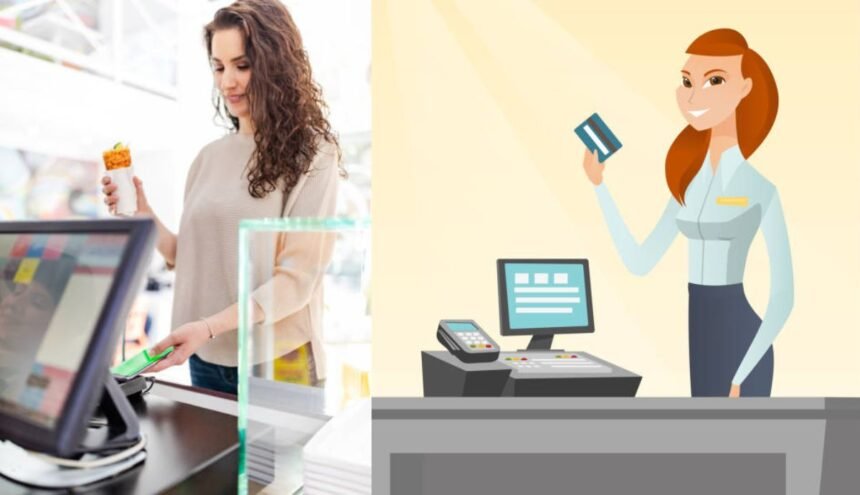Major retailers Costco and Walmart are moving away from self-checkout systems in select stores after years of customer complaints and surging theft rates.
The shift comes as shoppers voice growing frustration with the self-service kiosks, while loss prevention experts warn that the unmanned stations have exacerbated shoplifting and organized retail crime. Industry leaders are now exploring new methods to appease customers, while cracking down on unlawful activity.
Removing Self-Checkouts Entirely
Walmart made the first move by completely removing self-checkout lanes from three locations in Albuquerque, New Mexico this month.
“We continually look at ways to provide our customers with the best shopping experience and that includes adjusting the checkout area in stores,” said Walmart spokesperson Josh Havens in an interview with Insider.
The big-box retailer has not indicated plans to eliminate self-checkouts from other stores. However, the pilot program in New Mexico may inform future strategies if it successfully improves customer satisfaction and mitigates product loss.
Enhanced Staff Presence Instead
Rather than abolishing self-checkouts altogether, Costco is strengthening employee presence around the machines. Workers at the membership warehouse chain will now examine customers’ membership cards and assist with scanning items at self-checkout kiosks.
Costco management anonymously informed CNBC that the measures aim to curb increased shoplifting rates since the adoption of self-checkout technology.
Industry experts confirm that tactic could help deter would-be thieves.
“If you had a retail store where 50 percent of transactions were through self-checkout, losses would be 77 percent higher,” loss prevention consultant Adrian Beck told CNN.
Surging Shrink Rates Drive Change
The push toward manned-checkouts comes as retailers report skyrocketing “shrink” rates, or losses due to theft, error, fraud, and other causes.
Target CEO Brian Cornell stunned investors this year when he revealed the chain expected $600 million in gross profit erosion due to rising shrink in the first half of 2022 alone. Overall, U.S. retailers lost over $94 billion to shrink last year, according to National Retail Federation (NRF) survey data.
“While shrink can be driven by multiple factors, theft and organized retail crime are increasingly urgent issues impacting our team and our guests and other retailers,” Cornell said.
Industry experts cite unmanned checkout lanes as a major contributor to those losses.
“Theft actually becomes easier at self-checkout because there are fewer cues to monitor undesirable behavior,” explained criminology professor Adrian Beck.
A 2022 survey of retailers found that over 60% reported an increase in shoplifting since implementing self-checkout. Dishonest customers can more easily skip scans, swap barcodes, or pass other tricks undetected without cashiers watching.
Organized crime rings have also exploited the autonomous tech to systematically steal high-value merchandise. By sending groups of shoplifters to blitz multiple stores at once, they can rake in thousands with little risk.
Customer Concerns Build
Along with commanding losses, self-checkouts have drawn ire from shoppers forced to weigh produce, scan items, bag groceries, and troubleshoot errors themselves.
Walmart shopper Devan Creel told KOB 4 news that self-checkout lanes created more hassle than convenience at his local store.
“Trying to wrangle my kids and get everything paid for correctly is hard when I have to be the cashier too,” Creel said.
Others have voiced frustration over long wait times and preference for human interaction. A survey last year found just 32% of U.S. consumers “loved” retail self-checkout, down from 47% in 2019.
“Many shoppers see staffed checkouts as more convenient overall,” explained retail technology expert Shep Hyken. “Plus, chatting with a friendly cashier enhances the shopping experience.”
Checkouts in Flux
As criticized self-checkouts join crowded aisles and unwanted items as fading retail trends, the future form of checkout remains unclear.
While some customers will welcome more staffed lanes, others have come to depend on self-service for quick trips. Retailers must balance those preferences while protecting bottom lines battered by record-level theft.
“This is an evolving situation,” said National Retail Federation spokesperson Molly Snyder. “Our members are trying different approaches to serve customers efficiently and safely.”
Walmart and Costco’s experiments with hybrid checkout models may emerge as a middle ground. Other chains are testing new tech to make self-service more secure, such as AI video monitoring or attaching security tags to every item.
“Retailers need to incorporate a multi-faceted strategy,” Beck advised. “There is no single solution.”
One thing is certain – the checkouts of the future cannot resemble those of the past. With customer tolerance and retail losses surging in equal measure, transformation is imperative.
“The old way is just not sustainable anymore,” warned retail analyst Stuart Gustafson. “Innovation is critical, but also understanding shopper needs and preferences.”





